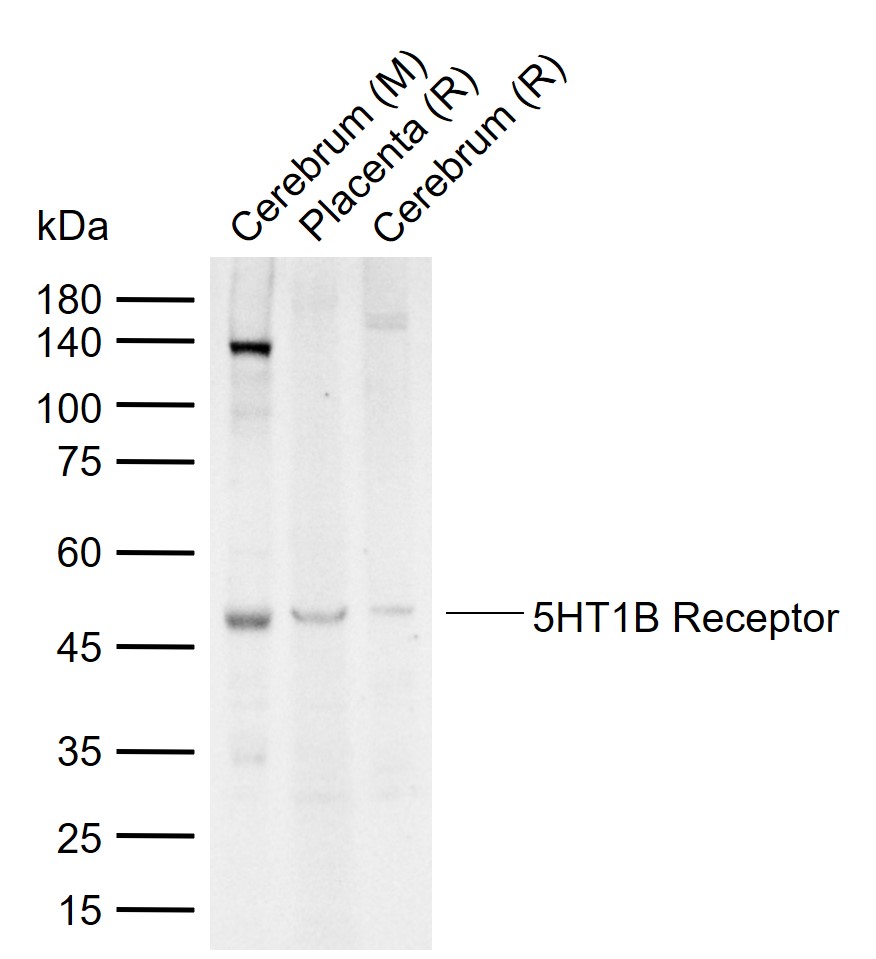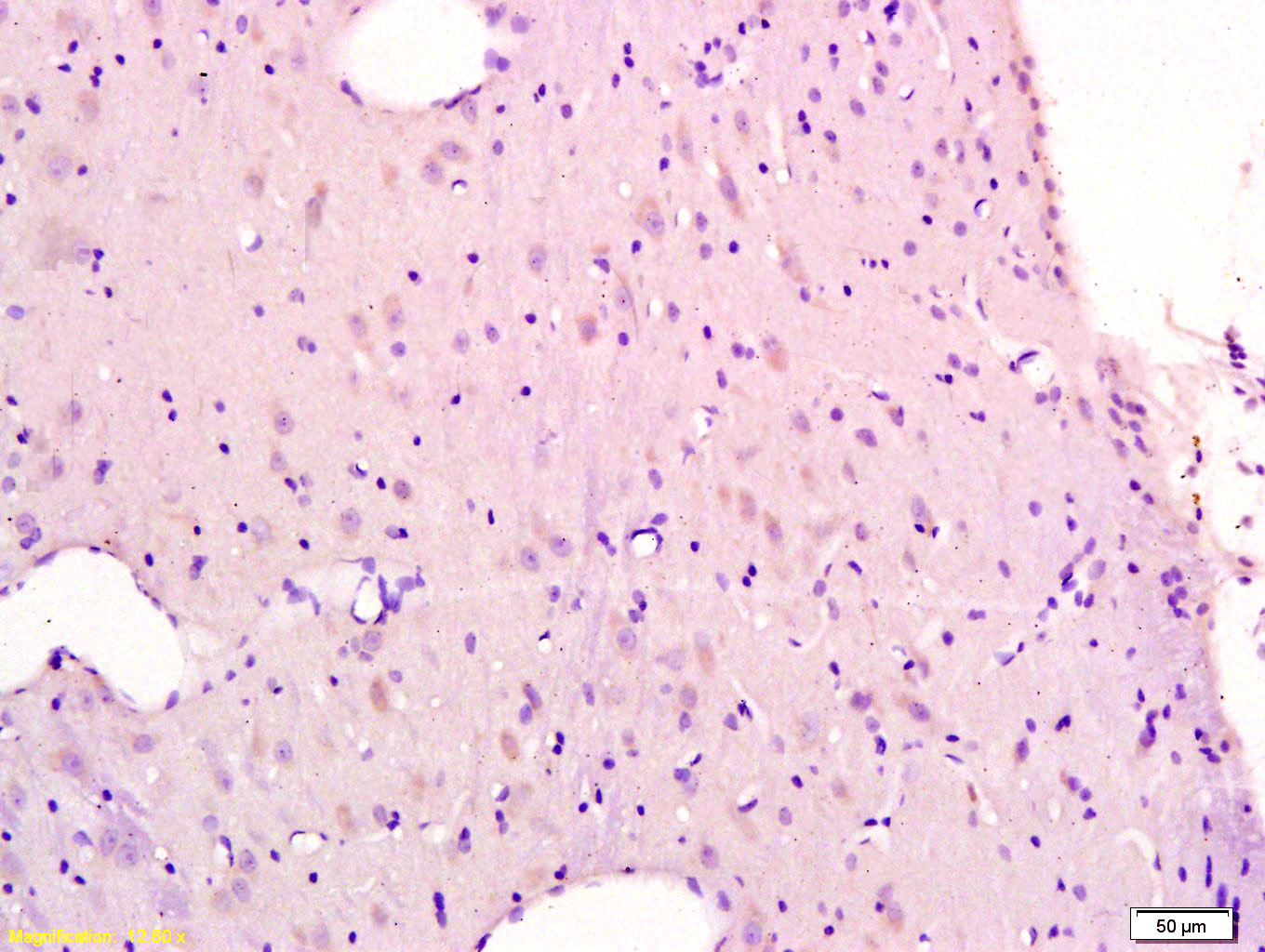5HT1B Receptor Rabbit pAb
5HT1B Receptor Rabbit pAb
- 产品详情
- 实验流程
- 背景知识
Application
| WB, IHC-P, IHC-F, IF |
|---|---|
| Primary Accession | P28222 |
| Reactivity | Mouse, Rat |
| Predicted | Human, Chicken, Dog, Pig, Horse, Rabbit |
| Host | Rabbit |
| Clonality | Polyclonal |
| Calculated MW | 43568 Da |
| Physical State | Liquid |
| Immunogen | KLH conjugated synthetic peptide derived from human 5-HTR1B |
| Epitope Specificity | 121-220/390 |
| Isotype | IgG |
| Purity | affinity purified by Protein A |
| Buffer | 0.01M TBS (pH7.4) with 1% BSA, 0.02% Proclin300 and 50% Glycerol. |
| SUBCELLULAR LOCATION | Cell membrane; Multi-pass membrane protein. |
| SIMILARITY | Belongs to the G-protein coupled receptor 1 family. |
| Post-translational modifications | Phosphorylated. Desensitization of the receptor may be mediated by its phosphorylation. Palmitoylated. |
| Important Note | This product as supplied is intended for research use only, not for use in human, therapeutic or diagnostic applications. |
| Background Descriptions | The neurotransmitter serotonin (5-hydroxytryptamine; 5-HT) exerts a wide variety of physiologic functions through a multiplicity of receptors and may be involved in human neuropsychiatric disorders such as anxiety, depression, or migraine. These receptors consist of several main groups subdivided into several distinct subtypes on the basis of their pharmacologic characteristics, coupling to intracellular second messengers, and distribution within the nervous system (Zifa and Fillion, 1992 [PubMed 1359584]). The serotonergic receptors belong to the multigene family of receptors coupled to guanine nucleotide-binding proteins.[supplied by OMIM, Oct 2009]. |
| Gene ID | 3351 |
|---|---|
| Other Names | 5-hydroxytryptamine receptor 1B, 5-HT-1B, 5-HT1B, S12, Serotonin 1D beta receptor, 5-HT-1D-beta, Serotonin receptor 1B, HTR1B (HGNC:5287), HTR1DB |
| Dilution | WB=1:500-2000,IHC-P=1:100-500,IHC-F=1:100-500,IF=1:100-500 |
| Storage | Store at -20 °C for one year. Avoid repeated freeze/thaw cycles. When reconstituted in sterile pH 7.4 0.01M PBS or diluent of antibody the antibody is stable for at least two weeks at 2-4 °C. |
| Name | HTR1B (HGNC:5287) |
|---|---|
| Synonyms | HTR1DB |
| Function | G-protein coupled receptor for 5-hydroxytryptamine (serotonin) (PubMed:10452531, PubMed:1315531, PubMed:1328844, PubMed:1348246, PubMed:1351684, PubMed:1559993, PubMed:1565658, PubMed:1610347, PubMed:23519210, PubMed:23519215, PubMed:29925951, PubMed:8218242). Also functions as a receptor for ergot alkaloid derivatives, various anxiolytic and antidepressant drugs and other psychoactive substances, such as lysergic acid diethylamide (LSD) (PubMed:23519210, PubMed:23519215, PubMed:29925951). Ligand binding causes a conformation change that triggers signaling via guanine nucleotide-binding proteins (G proteins) and modulates the activity of downstream effectors, such as adenylate cyclase (PubMed:10452531, PubMed:1315531, PubMed:1328844, PubMed:1348246, PubMed:1351684, PubMed:1559993, PubMed:1565658, PubMed:1610347, PubMed:23519210, PubMed:23519215, PubMed:29925951, PubMed:8218242). HTR1B is coupled to G(i)/G(o) G alpha proteins and mediates inhibitory neurotransmission by inhibiting adenylate cyclase activity (PubMed:29925951, PubMed:35610220). Arrestin family members inhibit signaling via G proteins and mediate activation of alternative signaling pathways (PubMed:29925951). Regulates the release of 5-hydroxytryptamine, dopamine and acetylcholine in the brain, and thereby affects neural activity, nociceptive processing, pain perception, mood and behavior (PubMed:18476671, PubMed:20945968). Besides, plays a role in vasoconstriction of cerebral arteries (PubMed:15853772). |
| Cellular Location | Cell membrane; Multi-pass membrane protein |
| Tissue Location | Detected in cerebral artery smooth muscle cells (at protein level). Detected in brain cortex, striatum, amygdala, medulla, hippocampus, caudate nucleus and putamen. |
For Research Use Only. Not For Use In Diagnostic Procedures.
Provided below are standard protocols that you may find useful for product applications.
BACKGROUND
The neurotransmitter serotonin (5-hydroxytryptamine; 5-HT) exerts a wide variety of physiologic functions through a multiplicity of receptors and may be involved in human neuropsychiatric disorders such as anxiety, depression, or migraine. These receptors consist of several main groups subdivided into several distinct subtypes on the basis of their pharmacologic characteristics, coupling to intracellular second messengers, and distribution within the nervous system (Zifa and Fillion, 1992 [PubMed 1359584]). The serotonergic receptors belong to the multigene family of receptors coupled to guanine nucleotide-binding proteins.[supplied by OMIM, Oct 2009].
终于等到您。ABCEPTA(百远生物)抗体产品。
点击下方“我要评价 ”按钮提交您的反馈信息,您的反馈和评价是我们最宝贵的财富之一,
我们将在1-3个工作日内处理您的反馈信息。
如有疑问,联系:0512-88856768 tech-china@abcepta.com.























 癌症的基本特征包括细胞增殖、血管生成、迁移、凋亡逃避机制和细胞永生等。找到癌症发生过程中这些通路的关键标记物和对应的抗体用于检测至关重要。
癌症的基本特征包括细胞增殖、血管生成、迁移、凋亡逃避机制和细胞永生等。找到癌症发生过程中这些通路的关键标记物和对应的抗体用于检测至关重要。 为您推荐一个泛素化位点预测神器——泛素化分析工具,可以为您的蛋白的泛素化位点作出预测和评分。
为您推荐一个泛素化位点预测神器——泛素化分析工具,可以为您的蛋白的泛素化位点作出预测和评分。 细胞自噬受体图形绘图工具为你的蛋白的细胞受体结合位点作出预测和评分,识别结合到自噬通路中的蛋白是非常重要的,便于让我们理解自噬在正常生理、病理过程中的作用,如发育、细胞分化、神经退化性疾病、压力条件下、感染和癌症。
细胞自噬受体图形绘图工具为你的蛋白的细胞受体结合位点作出预测和评分,识别结合到自噬通路中的蛋白是非常重要的,便于让我们理解自噬在正常生理、病理过程中的作用,如发育、细胞分化、神经退化性疾病、压力条件下、感染和癌症。







